Abstract
Understanding mineral–fluid interactions in shale under supercritical CO2 (scCO2) conditions is relevant for assessing long-term geochemical containment. This study characterizes mineralogical transformations and elemental redistribution in five Caney Shale samples serving as proxies for reservoir (R1, R2, R3) and caprock (D1, D2) facies, subjected to 30-day static exposure to pure scCO2 at 60 °C and 17.23 MPa (2500 psi), with no brine or impurities introduced. SEM-EDS analyses were conducted before and after exposure, with mineral phases classified into silicates, carbonates, sulfides, and organic matter. Initial compositions were dominated by quartz (38–47 wt.%), illite (16–23 wt.%), carbonates (12–18 wt.%), and organic matter (8–11 wt.%). Post-exposure, carbonate loss ranged from 15 to 40% in reservoir samples and up to 20% in caprock samples. Illite and K-feldspar showed depletion of Fe2+, Mg2+, and K+ at grain edges and cleavages, while pyrite underwent oxidation with Fe redistribution. Organic matter exhibited scCO2-induced surface alteration and apparent sorption effects, most pronounced in R2 and R3. Elemental mapping revealed Ca2+, Mg2+, Fe2+, and Si4+ mobilization near reactive interfaces, though no secondary mineral precipitates formed. Reservoir samples developed localized porosity, whereas caprock samples retained more structural clay integrity. The results advance understanding of mineral reactivity and elemental fluxes in shale-based CO2 sequestration.
1. Introduction
Geologic carbon sequestration (CCS) is a leading strategy for reducing atmospheric CO2 levels through long-term storage in deep subsurface formations [1]. Shale formations, commonly utilized as caprocks, are now also being explored as storage media due to their fine-grained texture, high clay content, and nanoporous structure [2]. These characteristics enhance surface reactivity and support mechanisms such as sorptive trapping and geochemical immobilization.
Exposure of shale to supercritical CO2 (scCO2) can initiate a range of mineral–fluid interactions. Carbonate phases may undergo dissolution; phyllosilicates, particularly illite, can experience elemental leaching and structural disruption; and sulfides like pyrite may oxidize. These transformations can alter porosity, permeability, and long-term seal integrity [3,4]. Clay minerals are especially chemically reactive due to their high surface area and exchangeable interlayer cations, which contribute to buffering and ion transport under scCO2 conditions [5,6]. Additionally, scCO2 has a higher diffusivity than water, allowing it to access mineral surfaces more efficiently and drive reactions within micro/nanopores and microfractures [7].
Previous studies have frequently incorporated brine or gas impurities, making it difficult to isolate the effects of CO2 alone. Mineral transformations occur in shales under scCO2–SO2 conditions [8], but the independent behavior of shale minerals in the presence of pure scCO2 remains poorly understood. Moreover, comparative data on reservoir and caprock lithofacies from the same shale formation under identical conditions are limited. Figure 1 illustrates the various study gaps and our comprehensive experimental ideology.
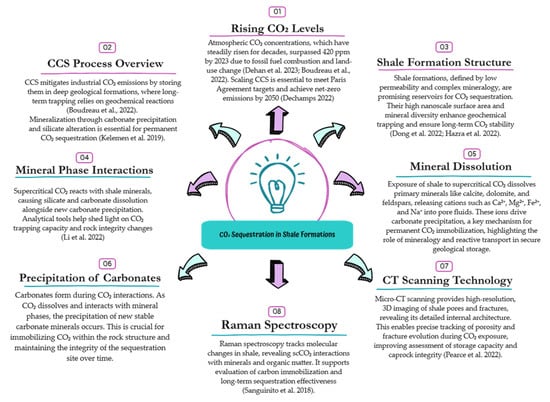
Figure 1.
Summarized context of the research and the key questions this study covers [5,9,10,11,12,13,14,15,16].
This study addresses that gap by examining mineralogical and geochemical changes in reservoir- and caprock-proxy samples from the Caney Shale after static exposure to pure scCO2 at 60 °C and 17.23 MPa (2500 psia) for 30 days. Pre- and post-exposure characterization was performed using scanning electron microscopy with energy-dispersive X-ray spectroscopy (SEM-EDS), computed tomography (CT), and RAMAN spectroscopy to assess mineral phase changes, elemental redistribution, and structural modifications. The objective is to determine the following: (1) which mineral phases exhibit early-stage reactivity under pure scCO2 conditions; (2) how reactivity differs between reservoir and caprock proxies; and (3) what microstructural features indicate the onset of mineral trapping or porosity evolution. By integrating SEM-EDS, CT, and RAMAN spectroscopy with systematic phase classification across distinct lithofacies, this study establishes a baseline for understanding the intrinsic reactivity of shale formations under pure CO2 conditions. The next section outlines the experimental setup, sample selection, and analytical procedures used to evaluate these transformations.
Insights from the literature review account for various research aspects, which this study will seek to answer. Table 1 provides a summary of the comprehensive literature.

Table 1.
Literature review and gaps identified for a refined approach to our methodology.
2. Materials and Methods
Shale samples were sourced from the Caney Formation found within the South-Central Oklahoma Oil Province (SCOOP) in the Ardmore basin, characterized by fine-grained, organic-rich lithofacies. Two distinct zones were selected to represent reservoir and caprock analogs: Reservoir-proxy samples (R1, R2, R3) originated from the brittle zone and Caprock-proxy samples (D1, D2) came from the ductile zone. Figure 2 shows our experimental flow.
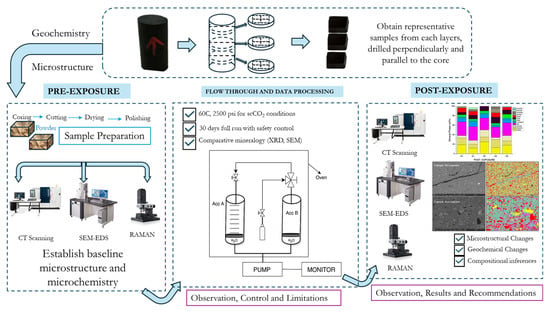
Figure 2.
Comprehensive methodology. Accumulator (Acc.) B is filled with CO2 and set to the supercritical conditions of 35 °C and 8.27 MPa, and increased progressive in steps of 0.7 MPa and 5 °C to reaction conditions (60 °C and 17.2 MPa). This is performed with Acc. A closed. Accumulator A contains the shelve on which the samples are stacked on trays, avoiding any contamination. Pressure is maintained using an Isco dual piston pump.
Samples were cut and polished into 1 cm × 1 cm × 0.5 cm cubical for exposure to scCO2. For each sample, two orientations were obtained: one parallel and one perpendicular to the bedding plane. This approach captured anisotropic responses to scCO2 exposure. Each analyzed surface was further segmented into four quadrants and a central point (Point 5) to account for heterogeneity during post-exposure analysis.
Pre and Post-exposure characterization involved a combination of imaging and spectroscopic methods to evaluate structural and chemical alterations (Figure 3). Unless otherwise stated, the equipment used are located at the Barrier Materials and Geomimicry lab. Due to the scale of interpretation, the CT scan, using Yxlon FF20 CT High-resolution (Comet Yxlon, Hamburg, Germany) was not adequate for this experiment and next experiments we plan to employ nano-CT. Samples were analyzed using scanning electron microscopy with energy-dispersive X-ray spectroscopy (SEM-EDS) using SEM imaging was carried out using a SCIOS Scanning Electron Microscope located at the OSU microscopy laboratory (Columbus, OH, USA). Quadrant-based mapping and a central point (Point 5) were examined at magnifications ranging from 500× to 5000×. Phases were classified as silicates (quartz, illite, feldspar), carbonates (calcite, dolomite), sulfides (pyrite), and organic matter. Elemental maps were used to track Fe, Mg, Ca, Si, K, and Al redistribution. Raman analysis was performed using an Alpha 300 R Raman Imaging Microscope (WITec GmbH, Ulm, Germany) over a 1 × 1 cm area, with spatial resolution of approximately 1 µm. Both 532 nm and 785 nm excitation lasers were employed. Spectra were acquired using 20× and 50× objective lenses, with the 532 nm laser dispersed by a 600 g/mm grating (BLZ = 500 nm). Laser power ranged from 0.5 to 5 mW, and the integration time was set to 1 s. This method identified shifts in carbonate peak positions, disordering in clay mineral structures, and potential alterations in organic matter. Spectra were collected at 20× magnification to support correlation with SEM-EDS data.
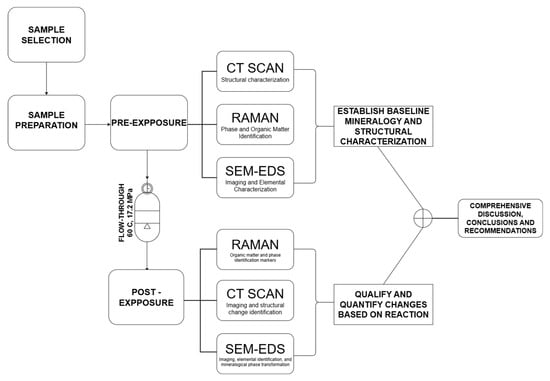
Figure 3.
Experimental flowchart, displaying the thought-process and symbiotic use of microscopy and spectroscopy for phase identification and the effort to achieve scientific experimental results convergence towards understanding reaction mechanisms and their potential field consequences.
3. Results
Post-exposure SEM-EDS analyses revealed distinct mineralogical changes across reservoir and caprock facies, driven by phase-specific reactivity to scCO2. This section details the identified mineral phases, their compositional shifts, and morphological alterations after 30-day exposure.
3.1. Mineral Phase Identification
Qualitative and morphological analyses from SEM-EDS revealed clear mineralogical heterogeneity across the Caney Shale facies. Samples were mapped at five locations per face four quadrants and a central point to ensure spatial representativity. SEM-backscattered imaging and EDS revealed distinct phase compositions and early-stage alterations across the Caney Shale samples after 30 days of pure scCO2 exposure. Reservoir and caprock proxies showed both compositional heterogeneity and phase-specific responses following scCO2 exposure. All five samples exhibited increases in organic matter (OM) visibility, while silicate and sulfate phases developed locally under reactive conditions. Primary mineral phases identified include quartz, illite, calcite, dolomite, K-feldspar, pyrite, and organic matter as shown in Figure 4, with a cross mineralogical comparison in Figure 5. Phase names followed standard SEM-EDS conventions. Where polymorphs were possible, identification was guided by morphology and elemental context; ambiguous cases used broader terms with noted limitations.
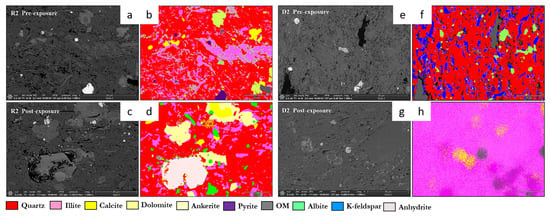
Figure 4.
Mineral phase variability between reservoir and caprock proxies shown through SEM and mineral phase maps of R2 (a–d) and D2 (e–h) before and after scCO2 exposure, illustrating facies-specific mineralogical transformations and implications for CO2 sequestration. R2 (a–d)—The reservoir facies exhibit significant mineral reactivity, with pre-exposure assemblages of quartz, illite, anhydrite, albite, calcite, and ankerite transitioning to a more reactive post-exposure system marked by secondary dolomite, kaolinite, pyrite, and abundant organic matter. Widespread feldspar and carbonate dissolution, coupled with illite compositional changes, reflect active fluid–mineral interactions enhancing both porosity and mineral trapping potential. D2 (e–h)—In contrast, the caprock facies remains comparatively stable. While pre-exposure composition includes OM, illite (K and Na), and ankerite, post-exposure changes are more subdued, characterized by moderate growth in kaolinite and dolomite, persistence of illite, and limited carbonate transformation. This mineralogical resilience, dominated by low-permeability clays, supports long-term capillary sealing and geochemical buffering under dry scCO2 conditions.
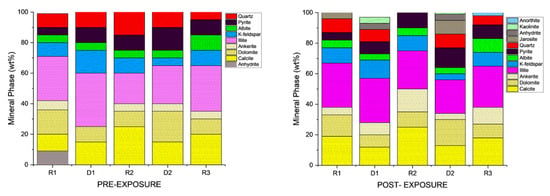
Figure 5.
Bulk mineralogical compositions pre and post CO2 exposure for the reservoir and caprock proxies, based on EDS results and compared with x-ray diffraction. In reservoirs, scCO2 induced clear transformations: organic matter increased substantially (R2: 6.57 to 12.77 wt.%), while calcite and ankerite declined (R2 calcite: −1.21 wt.%, ankerite: −1.16 wt.%). New phases such as dolomite, jarosite, and wollastonite emerged, indicating active carbonate alteration and secondary mineral formation. Quartz and illite remained relatively stable. In caprock proxies, changes were more restrained. Organic matter still rose sharply (D2: 6.99 to 14.19 wt.%), with minor reductions in calcite and pyrite, and the appearance of jarosite and calcium sulfate. Key clays (illite, kaolinite) and framework silicates showed minimal change, reflecting strong geochemical variations.
- Quartz remained the principal framework silicate across all facies. In reservoir proxies, pre-exposure abundances were 43.77 wt.% (R1), 42.23 wt.% (R2), and 45.96 wt.% (R3), with post-exposure values of 43.94 wt.%, 42.22 wt.%, and 45.68 wt.%, respectively. In caprock proxies, quartz accounted for 33.79 wt.% (D1) and 33.69 wt.% (D2) prior to exposure, increasing marginally to 34.13 wt.% (D1) and decreasing to 32.75 wt.% (D2) post-exposure. Across all facies, quartz grains retained angular, sharp morphologies with no significantly observable structural or chemical alteration.
- K-Feldspar (KAlSi3O8). K-feldspar was consistently present in all samples. In reservoirs, values ranged from 5.06 to 5.84 wt.% pre-exposure and from 5.89 to 5.99 wt.% post-exposure. In D1 and D2, K-feldspar were 7.06 wt.% and 6.54 wt.% pre-exposure, increasing to 7.13 wt.% in D1 and decreasing mildly to 6.36 wt.% for D2 post-exposure. No dissolution or surface roughening was evident under SEM imaging.
- Illite [(K,H3O)(Al,Mg,Fe)2(Si,Al)4O10(OH)2]. Illite occurred in all facies and was typically distributed along grain boundaries or within clay-rich matrices. Illite content in the reservoir proxies increased from 17.69 to 17.61 wt.% (R3) and 18.40 to 18.67 wt.% (R2). In caprock proxies, illite content increased from 17.26 to 17.47 wt.% (D1) and 16.31 to 16.68 wt.% (D2); pre and postexposure. Platy textures remained intact, although localized thinning and roughening of particle edges were noted in R2 and R3.
- Kaolinite (Al2Si2O5(OH)4). Kaolinite was identified in D1 and D2. Its abundance increased from 10.03 to 10.13 wt.% (D1) and decreased from 9.89 to 9.76 wt.% (D2); pre and post-exposure, respectively. Kaolinite maintained blocky morphology with no signs of chemical erosion or micro-pitting.
- Paragonite (NaAl2(Si3Al)O10(OH)2). Paragonite was not detected in any sample prior to exposure. Post-exposure, it appeared in R2 (0.38 wt.%), R3 (0.88 wt.%), D1 (0.72 wt.%), and D2 (0.90 wt.%). It was typically observed near altered illite flakes and within fine-grained matrix zones, forming as secondary Na-bearing phyllosilicate lamella.
- Calcite (CaCO3). Calcite was present in all samples, particularly in the reservoir facies. Calcite decreased slightly from 9.92 to 9.01 wt.% (R1), 9.97 to 8.76 wt.%, and increased from 8.80 to 9.05 wt.% (R3). In caprocks, it increased from 9.41 to 9.75 wt.% (D1) and decreased from 9.62 to 8.80 wt.% (D2). SEM images revealed surface pitting and edge retreat, especially in R1 and R2.
- Ankerite [Ca(Fe2+,Mg)(CO3)2]. Ankerite occurred in both reservoir and caprock proxies. In R1–R3, pre-exposure values ranged from 4.40 wt.% to 5.49 wt.%, decreasing post-exposure to 4.08–4.33 wt.%. In D1, it was not detected pre-exposure and remained absent post-exposure. In D2, it decreased from 4.02 wt.% to 3.55 wt.%. Morphologies were retained but with localized surface dulling near grain boundaries.
- Wollastonite (CaSiO3). Wollastonite was absent prior to exposure and formed in all samples post-exposure. In R1–R3, abundances were 0.67 wt.%, 1.08 wt.%, and 1.02 wt.%, respectively. In D1 and D2, wollastonite was recorded at 0.56 wt.% and 0.93 wt.%. It appeared as fibrous or acicular precipitates localized around sites of prior carbonate dissolution.
- Albite (NaAlSi3O8). Albite was present in every sample, and its presence in R1 had minimal increase from 4.88 to 5.75 wt.% and in R3 it was a negligible change from 5.96 wt.% preexposure to 5.94 wt.% post-exposure. In D1 and D2, albite changed from 4.71 wt.% and 4.82 wt.% to 4.93 wt.% and 4.65 wt.%, respectively, all of which are within experimental error limits due to sample heterogeneity. Grains retained sharp outlines and showed no signs of dissolution.
- Pyrite (FeS2). Pyrite was present across all facies. In reservoirs, pre-exposure values ranged from 4.88 wt.% (R1) to 5.87 wt.% (R2), declining to 4.67–5.41 wt.% post-exposure. In D1 and D2, pyrite decreased from 6.28 wt.% and 6.26 to 5.56 wt.% and 4.84 wt.%, respectively. SEM showed edge diffusion and oxidation halos near OM and clay interfaces in caprock samples.
- Jarosite [KFe3(SO4)2(OH)6]. No jarosite was detected in Caney shale prior to exposure to scCO2, in this study it was identified post-exposure in R1 (0.58 wt.%), D1 (1.24 wt.%), and D2 (1.49 wt.%), with trace detection in R2. No formation was observed in R2. It formed as fine-grained spikelet aggregates, frequently bordering anhydrite, pyrite and organic-rich regions.
- Anhydrite (CaSO4·2H2O). Anhydrite was detected pre-exposure and post-exposure in reservoir and caprock proxies; notably: 0.80 wt.% in D1 and 1.07 wt.% in D2. It appeared as thin, patchy coatings at mineral boundaries. The CaSO4 phase was identified as anhydrite, based on its dehydrated state and the high-temperature SEM-EDS preparation conditions. Given that EDS does not detect hydration state, gypsum or basanite cannot be ruled out entirely, but the thermal and vacuum conditions favor the anhydrite form.
- Organic Matter (CxHyOz). Organic matter was found in all samples, increasing post-exposure in every case. In R1–R3, OM increased from 5.17 wt.%, 6.57 wt.%, and 5.99 wt.% pre-exposure to 10.79 wt.%, 12.77 wt.%, and 11.89 wt.%, respectively. In D1 and D2, OM rose from 6.66 wt.% and 6.99 to 12.15 wt.% and 14.19 wt.%, respectively. Post-exposure OM showed increased surface roughness, irregularity, and porosity development.
Table 2 below summarizes the average elemental composition of each phase as detected and analyzed using SEM-EDS. Mineral phases identified via SEM-EDS were classified based on dominant elemental signatures. We acknowledge natural phases may form solid solutions; names reflect dominant composition rather than pure endmembers.

Table 2.
Average EDS classification of mineral phases.
3.2. Chemical Elemental Mobilization
Variations in K+, Ca2+, Mg2+, Na+, SO24−, and Fe2+/3+ are recorded across R1. K+ and Na+ signals decrease alongside a reduction in K-feldspar abundance (13.6 to 10.2 wt.%) and Albite (5.0 to 3.4 wt.%). Ca2+ and Mg2+ shifts correspond to marked declines in Calcite (18.0 to 11.2 wt.%) and Ankerite (5.0 to 2.1 wt.%). SO42− release is supported by the disappearance of Anhydrite (2.5 wt.% pre-exposure). A drop in Pyrite content (3.2 to 1.4 wt.%) aligns with trace-level Fe2+ observations. Illite (27 wt.%) and Quartz (24.7 wt.%) show no significant quantitative change. Minor components such as Kaolinite (<1.5 wt.%) remain within detection limits without notable change.
Ionic reductions are inferred for K+, Ca2+, Mg2+, SO42−, and Fe2+ in D1. These align with the measured loss in K-feldspar (14.3 to 9.8 wt.%) and Illite (26.7 to 22.9 wt.%), as well as Calcite (15.4 to 9.3 wt.%) and Dolomite (12.2 to 8.0 wt.%). Sulfur-bearing phases show change, with Anhydrite declining from 3.0 to <1.0 wt.%. Pyrite decreases to 2.1 wt.%, and minor Fe signals are present in adjacent altered zones. Na+ remains stable, with Albite retaining 3.2 wt.%. Quartz (24 wt.%) and minor phases such as Kaolinite and organic matter (1 wt.%) do not register significant variation.
In R2, changes in K+, Ca2+, Mg2+, SO42−, and Fe2+ are evident. K-feldspar content declines from 12.7 to 8.4 wt.%, and Illite from 21.9 to 19.2 wt.%. Calcite and Dolomite decrease to 10.1 and 6.3 wt.%, respectively, reflecting a reduction in Ca2+ and Mg2+ during carbonates reprecipitation. Anhydrite, originally present at 2.8 wt.%, is no longer detected post-exposure, consistent with increased SO42− signal. Pyrite falls to 2.3 wt.%, with Fe2+/3+ signal diffusion around previous grain boundaries. Albite (3 wt.%) and Na+ levels remain stable. Quartz holds at 24.6 wt.%. Kaolinite (1.1 wt.%) and organic matter (0.9 wt.%) are preserved without apparent shifts.
The reduction of Ca2+, Mg2+, K+, and SO42− is confirmed across D2. This corresponds with decreased proportions of Calcite (17.5 to 11.6 wt.%), Dolomite (11.8 to 7.5 wt.%), and K-feldspar (13.2 to 8.9 wt.%). Illite shifts slightly (19.6 to 17.1 wt.%), while Anhydrite (2.6 wt.%) is fully absent post-exposure, with elevated sulfur signals noted in former anhydrite-bearing regions. Pyrite declines to 1.7 wt.%, with minor Fe presence. Albite ranges from 3.1 to 2.6 wt.%, with negligible Na+ signal deviation. Quartz (~23.9 wt.%) and minor minerals such as Kaolinite, organic matter, and trace phosphates show no measurable alteration.
SEM-EDS elemental mapping indicates selective post-exposure mobilization of K+, Ca2+, Mg2+, Fe2+, and SO42− across facies. Carbonate-bearing zones in R1, R2, and R3 show marked Ca2+ and Mg2+ depletion, consistent with mineral phase volume loss from Calcite, Dolomite, and Ankerite. Pyrite-associated Fe2+/3+ and S(SO42−) signals decrease, with partial redistribution observed in caprock proxies such as D2. Illite grains exhibit localized leaching of K+, Mg2+, and Fe2+/3+, particularly in the reservoir proxies. In contrast, Si and Al remain stable, reflecting Quartz and K-feldspar persistence. Organic matter becomes more spatially distributed post-exposure, especially along former carbonate-clay boundaries. No secondary precipitates were detected within the 30-day interval, though surface alterations indicate potential reactivity under extended conditions. Figure 6 and Figure 7 give a sample observation of a key feature observed post reaction for a caprock and reservoir proxy.

Figure 6.
SEM of R1–Point 5 (reservoir proxy) before (left) and after (right) scCO2 exposure, showing mineralogical transformations. Pre-exposure images reveal calcite, dolomite, pyrite, and organic matter within a silicate framework. Post-exposure, new jarosite forms alongside dolomite, ankerite, and anhydrite near OM-rich zones. Jarosite, resulting from pyrite oxidation, enhances CO2 trapping through sulfate crystallization, introduces micro-porosity, and contributes to grain-scale stability, highlighting its key role in long-term sequestration and reservoir reinforcement.
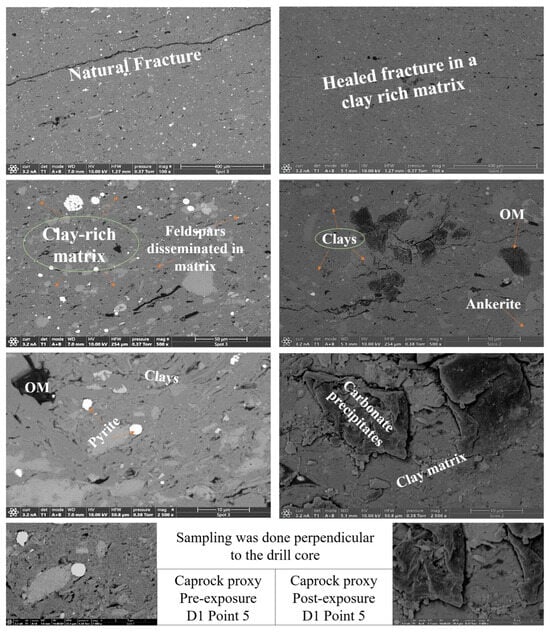
Figure 7.
D1 Caprock proxy pre and post exposure. SEM images of D1A–Point 5 (caprock proxy) before (left) and after (right) scCO2 exposure, showing textural and mineralogical changes. Pre-exposure images reveal a fine-grained, clay-rich matrix with disseminated feldspars. Post-exposure, the caprock surface shows enhanced expression of clays and feldspars, alongside preserved organic matter and ankerite. The increased concentration of clays suggests mineral stabilization and enrichment, reinforcing the caprock’s sealing capacity and long-term geochemical integrity following scCO2 injection.
Table 3 is a summary of the ionic and elemental species mobilized during the reaction, these species are as detected through EDS. Equally, the table provides a link to the geochemical reaction paths attributed to these mobilizations.

Table 3.
From ionic mobilizations to sequestration, a summary of the potential ionic mobilizations.
4. Discussion
4.1. Mineral Stability and Reactivity
The early-stage mineralogical and microstructural changes observed in the Caney Shale samples have important impact on the long-term safety and effectiveness of geologic carbon sequestration. The Caney Shale demonstrates that supercritical CO2 (scCO2) exposure initiates diverse mineralogical transformations, largely governed by facies-level differences in composition, porosity, and reactivity. While the broad categories of carbonate dissolution and clay interaction have been widely reported in other shales, this study reveals the importance of sulfate-related transformations and the catalytic role of organic matter. These findings support a nuanced understanding of geochemical reactivity across mechanically distinct lithologies [15] and provide some insights for carbon storage safety and long-term relevance.
4.1.1. Carbonate Phases
Reservoir facies such as R2A and R3A displayed extensive dissolution of calcite and ankerite. This pattern confirms earlier observations of carbonate reactivity under CO2-rich conditions [23], where the release of Ca2+, Mg2+, and Fe2+ ions initiates buffering and supports the early stages of mineral trapping [34]. In contrast to previous findings where reprecipitation was considered minimal without brine [14], this study provides evidence of secondary precipitation even under nominally dry conditions. Carbonate reactivity is a major gateway to geochemical sequestration of CO2. No discrete Ca-silicate phases such as wollastonite were identified. Ca–Si signals observed in Raman and EDS maps are likely attributable to mixed silicate-carbonate domains or poorly crystalline components associated with clay-carbonate interfaces [35]. Figure 8 is an illustration of these. The formation of calcium silicate (wollastonite) indicates that these carbonates did not simply dissolve but instead facilitated new stable mineral assemblages. While carbonate dissolution may initially release CO2 or buffering cations (e.g., Ca2+, Mg2+), subsequent carbonation and mineral re-precipitation contribute significantly to long-term geochemical trapping [13]. This dual behavior positions carbonate reactivity as a key mechanism in CO2 sequestration under dry supercritical conditions [36]. Such transformations are reported to arise through coupled reactions involving silicate-structural and carbonate-derived cations [32]. Their spatial localization near feldspar-carbonate-OM boundaries suggests that geochemical trapping in a mineralogically diverse shale rocks is interface-driven rather than single mineral surface reaction phenomena (homogeneous). This behavior underscores the importance of interfacial mineralogy in shaping the spatial pattern of storage efficiency.

Figure 8.
Mineral phase maps and backscattered SEM images from R3 illustrating carbonate phase evolution before and after scCO2 exposure. In the pre-exposure image (a), a naturally filled fracture is observed cutting through the matrix, with the corresponding EDS phase map (b) showing ankerite and calcite phases localized along the fracture and at feldspar–carbonate interfaces. Post-exposure imaging (c) reveals a completely sealed fracture, consistent with carbonate re-precipitation and in situ sealing. The post-exposure phase map (d) highlights redistribution and partial reduction of carbonate phases, with transformation at mineral boundaries and localized infill zones dominated by fine-grained reaction products. This supports evidence for carbonate re-precipitation and sealing under dry scCO2 conditions.
4.1.2. Clays and Feldspars
Clay minerals exhibited distinct responses across facies. In the ductile caprock settings of D1 and D2, illite displayed edge thinning alongside localized transformation into paragonite, accompanied by an overall increase in illite presence. This trend is consistent with illitization, potentially driven by minor Na+ availability from albite or residual interstitial fluids [37,38]. Alterations observed near clay boundaries under low-water conditions suggest that clay phases can undergo mineralogical adjustment, contrary to prior assumptions of their inert behavior in scCO2 environments, particularly where thin water films persist [39,40]. The increased clay content, along with progressive illitization, is associated with enhanced ductility and greater sealing capacity in the caprock proxies [30,32]. Feldspars, while structurally preserved, show signs of active chemical exchange. Slight K+ depletion and surface etching, particularly in R1 and R3, point to early-stage hydrolysis [41]. These reactions may facilitate the formation of secondary clays or contribute mobile cations relevant to CO2 trapping processes. The involvement of feldspars in such geochemical interactions reflects long-term alteration patterns observed in sedimentary basins [14], although their direct contribution to mineral trapping remains limited. Clays and feldspar serve as alteration controllers and ion exchange sites. Figure 9 illustrates the clay mobilization in the caprock proxy D1.

Figure 9.
Pre- and post-exposure SEM and EDS analyses of D1 caprock facies (a–d) illustrate fracture evolution and mineral transformation. In the pre-exposure SEM image (a), natural fractures follow mineral boundaries, likely resulting from depositional compaction and early diagenesis. The corresponding EDS map (b) highlights clay-rich zones along these fractures, marking sites of mechanical weakness. Post-exposure SEM imaging (c) reveals calcite-filled healed fractures and newly formed reaction-induced fractures attributed to mineral dissolution and stress redistribution under scCO2 exposure. The EDS phase map (d) shows spatial redistribution of phases, with carbonate precipitation localized at fracture tips and clay–mineral interfaces. Illite edges show thinning, paragonite appears along fracture margins, and feldspar grains exhibit incipient etching. Fracture infill is composed of fine-grained alumino-silicates, consistent with in situ transformation products.
4.1.3. Sulfide Oxidation and Sulfate Reaction Pathways
Formation of jarosite and additional anhydrite (CaSO4) was observed in both reservoir and caprock facies following scCO2 exposure. These phases are associated with pyrite oxidation and redistribution of sulfate from pre-existing anhydrite. Their presence in a closed system, containing only scCO2 and no added SO2, indicates that sulfate-bearing phases can form under localized oxidative conditions. Co-occurrence with organic matter and likely trace water suggests that redox activity can occur in the absence of externally supplied oxidants, supporting Fe2+ and SO42− mobility in the various facies [15]. Sulfate-bearing phases, although less frequently emphasized in shale carbon storage contexts, are observed to persist under the experimental conditions. Jarosite was identified in multiple points, and both jarosite and anhydrite are known to exhibit stability under low pH and moderate temperature [23]. Jarosite spikelets as seen in Figure 6, show vast porosity created, giving more room for sequestration. Figure 10 shows the pre and postexposure EDS of the jarosite linked spot. Here, the reaction is hypothesized to initiate through pyrite oxidation, likely accelerated by the presence of trace porewater and redox-active OM [34]. This process releases Fe2+ and S2−, which, under oxidizing conditions, transition into Fe3+ and SO42− [42], ultimately forming jarosite through a precipitation reaction:
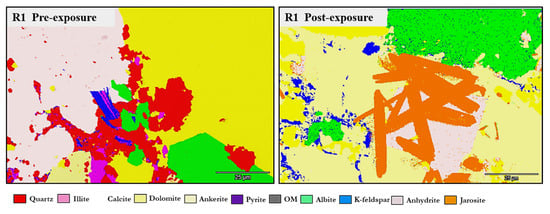
Figure 10.
Post-exposure mineral map shows newly formed jarosite in reservoir facies with adjacent porosity development, suggesting sulfate phase persistence under localized oxidative conditions.
Equation (1) shows the jarosite formation reaction which is thermodynamically favored under acidic, low ionic strength conditions [13]. Its appearance in a brine-free, scCO2 setting underscores the capability of shale-hosted systems to support complex redox mineral transformations without exogenous oxidants. Our results indicate that sulfate mineral formation can occur alongside carbonate reactivity, particularly in organic-rich zones where sulfide-CO2 interactions are spatially linked.
4.1.4. Organic Matter: A Chemically Active Interface
Organic matter played a dual role across all facies, Figure 11 illustrates this with R1 and D2. OM acted both as a high-affinity sorbent for scCO2 and as a catalytic interface for redox-mediated mineral reactions [43]. In ductile caprock facies, organic surfaces underwent fragmentation and porosity development, which enhanced their ability to store scCO2 in micropores [25]. These changes also supported electron transfer reactions, especially near pyrite and clay edges, fostering the nucleation of new mineral phases [44]. Organic matter can be defined in our context as a chemically active interface. The formation of illite-OM aggregates and secondary mineral patches at OM-clay boundaries confirm that organic matter supports not only CO2 uptake but also chemical transformation. Previous studies have shown the sorptive value of OM [12], but the current results demonstrate its capacity to induce mineral precipitation and stabilize reaction fronts. This behavior extends the functional relevance of organic matter from passive retention to active geochemical regulation within shale-hosted sequestration systems.
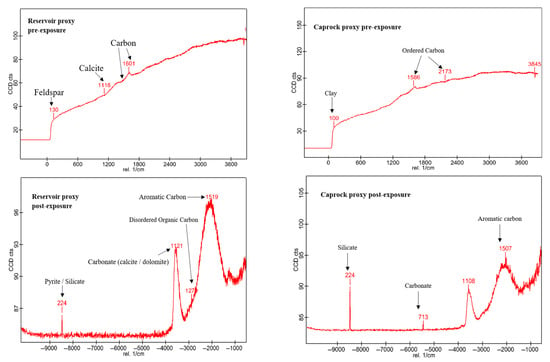
Figure 11.
Raman spectra of reservoir (R1) and caprock (D2) facies before and after exposure to scCO2 at 60 °C and 17.8 MPa. In the reservoir proxy (R1), carbon signals evolve from a broad disordered peak (~1601 cm−1) to distinct D and G bands at 1279 cm−1 (disordered/sp3 carbon) and 1519 cm−1 (aromatic/sp2 carbon), indicating increased structural ordering and aromatization. In the caprock proxy (D2), a similar transformation is observed, with the pre-exposure band at 1586 cm−1 shifting to a more defined aromatic signal at 1507 cm−1 post-exposure. Peaks associated with carbonate (~1108–1121 cm−1), silicate (~224 cm−1), and clay (~100–130 cm−1) are also present. These spectra confirm the retention and transformation of organic matter toward more graphitized forms under scCO2 conditions.
4.2. Relevance for Geochemical Sequestration
The mineral transformations and reactivity patterns observed in this study suggest that Caney Shale facies contribute to CO2 storage in distinct yet complementary ways. Reservoir units serve as the primary trapping domains through carbonate dissolution and re-precipitation. Ductile caprock facies, on the other hand, operate as chemical seals, limiting vertical migration and stabilizing CO2 through redox and sulfate-based reactions.
4.2.1. Reservoir Proxies
Proxies R1 through R3 are characterized by high quartz content combined with moderate amounts of reactive feldspars, carbonates, clays, and organic matter. Spatially localized dissolution and precipitation were observed, primarily concentrated along mineral boundaries and microstructural interfaces. R2 exhibited the most extensive carbonate loss, particularly of ankerite, followed by irregular precipitation of both carbonate and silicate phases. R3, with lower carbonate content, displayed greater expression of organic matter and sulfate reactivity, indicating multiple coexisting trapping mechanisms [45]. Such mineral–fluid interactions align with findings in other mixed-lithology reservoirs, where uneven carbonate distribution contributes significantly to mineralogical trapping [34]. The detection of Ca–Si-rich areas at silicate–carbonate-OM interfaces suggests the formation of calcium-bearing silicate assemblies [43]. While wollastonite (CaSiO3) was not conclusively identified, Raman and EDS data reveal spatially correlated Ca2+ and SiO2 signals consistent with possible low-crystallinity or transitional Ca–silicate compounds [44]. These mineral associations, though unresolved in structure, may represent additional trapping phases not typically emphasized in standard CCS models [7,46]. Such variability in mineral phases supports localized reactivity that could potentially enhances CO2 retention in texturally heterogeneous zones. The reservoir proxies are thus accounted for reactive porosity and multiphase trapping.
4.2.2. Caprock Proxies
Caprock proxies D1 and D2 retained structural integrity and low porosity following scCO2 exposure. Their composition rich in clays and organic matter, and the emergence of sealing-associated phases suggest a dominant geochemical sealing role rather than bulk-phase CO2 mineralization [47]. Compact microtextures were preserved post-exposure, and the presence of sulfate and redox-active phases was confirmed by both SEM-EDS and Raman analyses [3,48]. These features are consistent with current caprock performance models that emphasize ion retention and interfacial buffering over mechanical deformation. Sulfate mineralization and redox processes involving organic matter occur in the absence of external oxidants or brine immersion. The sealing behavior is reinforced by microscale dissolution–precipitation reactions that operate across reactive boundaries and enhance caprock resilience without compromising structural integrity [49]. These processes are not just passive but actively reinforce sealing through coupled dissolution and precipitation at the microscale. Caprock proxies are thus accounted for ensuring sealing (geochemically proven), hence confirming the dual nature of shales as for CO2 containment and leak prevention.
4.2.3. Integrated Storage Performance and Relevance for CCS Design
Facies-dependent responses in Caney Shale illustrate the function of an integrated trapping system in which porosity access, geochemical transformation, and redox buffering act concurrently. Reservoir zones enable CO2 migration and support mineral conversion along carbonate and sulfate pathways. Caprock layers contribute by limiting leakage through chemical immobilization and formation of clay barrier phases at reactive interfaces. Formation of sulfate-bearing minerals, calcium–silicate domains, and clay–organic composites under scCO2 exposure broadens the range of sequestration pathways beyond traditional carbonate-based considerations.
SEM-EDS analyses of Caney Shale samples exposed to scCO2 reveal dual effects: local mineral transformations support both self-sealing and mechanical weakening processes. Carbonate dissolution was frequently accompanied by precipitation of secondary phases at grain boundaries and within pore spaces, especially in reservoir facies such as R2 and R3. These fine-scale precipitates suggest activation of self-sealing pathways, even without brine, aligning with prior findings in clay–carbonate systems [35].
Similarly, microstructural weakening was evident in caprock facies. Illite exhibited sheet-edge thinning and minor delamination; pyrite showed early oxidation; and organic matter displayed fragmentation with increased surface porosity. Such alterations, most prominent in D1 and D2, raise concerns about clay integrity under prolonged exposure, consistent with reported CO2-induced softening of sealing units under low-water conditions [3]. The interplay between sealing and weakening is spatially variable and phase-dependent. In carbonate-rich zones, re-precipitation may enhance capillary sealing. In phyllosilicate-dominated domains, structural degradation may reduce long-term integrity, particularly under stress cycles associated with injection operations [2,28,50]. Observed phase transformations support a wider trapping framework that incorporates both primary reactions and secondary mineral development without reliance on brine or supplemental oxidants. Caney Shale demonstrates geochemical and structural reliability for long-term CO2 retention, with distinct yet complementary contributions from reservoir and caprock settings. Table 4 provides an overview of literature with the common mineral phases associated with CCUS and how they fit the purpose of our research.

Table 4.
Comparing observed mineralogical changes with CO2 interactions in shales.
4.3. Geochemical Insights
Mineral reactivity in the Caney Shale under scCO2 exposure is highly localized, driven by the spatial arrangement of reactive phases and interfacial microenvironments. Transformations occurred not uniformly, but along grain boundaries where carbonates, clays, sulfides, and organic matter converge. These interfaces enabled coupled processes such as ion exchange, redox cycling, and secondary phase nucleation. Consequently, this extends trapping pathways beyond carbonate dissolution. In Figure 12, illustrations of the observed mineral evolution reflect not just composition, but the connectivity and proximity of reactive constituents in both facies. Organic matter enhanced reactivity by supporting electron transfer and acting as a nucleation site, while stable phases like quartz and feldspar constrained reactions spatially. Overall, trapping efficiency in the Caney Shale appears controlled less by bulk mineralogy than by the distribution and interaction of components at the microscale.

Figure 12.
Shale exhibits dual-functionality for CO2 storage governed by facies-specific geochemical behavior. (a) The reservoir acts as a reactive matrix, promoting mineral dissolution, elemental redistribution, and stable secondary phase precipitation essential for geochemical trapping. (b) The caprock maintains low reactivity, enabling structural preservation through limited transformation and clay-stabilization, thereby supporting long-term seal integrity.
5. Conclusions
Exposure of Caney Shale to pure scCO2 at 60 °C and 17.23 MPa (2500 psia) induces rapid, phase-specific mineral reactions relevant to long-term carbon storage. Quartz remains chemically inert, while carbonates dissolve and locally re-precipitate as calcium- and iron-rich secondary phases. Illite exhibits edge alteration and cation leaching; pyrite undergoes early-stage oxidation; and organic matter becomes more porous, supporting redox activity at mineral interfaces. SEM-EDS analysis confirms that mineral trapping initiates under dry conditions, with nanometer-scale precipitates forming at grain boundaries and pore surfaces. Reactions are not uniformly distributed but are instead governed by spatial variability in mineral associations, surface properties, and interface geochemistry. Insights gained from this experiment include the following:
- Localized porosity development enhances CO2 injectivity, while secondary mineral precipitation at grain contacts and pore throats contributes to self-sealing behavior, supporting containment stability.
- Demonstrated mineral trapping in dry scCO2 (no added brines) systems confirms that water is not a prerequisite for initiating geochemical containment, with in situ precipitation providing a viable mechanism for immobilizing (sequestering) injected CO2.
- Facies-dependent reactivity, mineral phase and ionic species distribution support a naturally evolving balance between fluid migration pathways and geochemical seals. This allows reactive zones (reservoirs) to co-exist with stable, low-permeability zones (caprocks).
- Existing shale development from hydraulic fracturing offers an operational advantage, enabling CO2 storage to leverage established well infrastructure, reservoir access strategies, and field-scale monitoring systems.
Future work should explore sulfate phase formation, including jarosite (KFe3(OH)6(SO4)2), using combined with reactive-transport modeling and calculations. Integrating EDS-based stoichiometry with kinetic datasets will help quantify CO2 uptake across key mineral phases. Extending experiments to other shales will provide a crosslink benchmarking. Incorporating mineral-scale reaction rates into geomechanical and geophysical models can improve leakage-risk assessments, while EBSD and FIB-SEM will enable deeper characterization of reaction zones and deformation below the surface. These steps will sharpen monitoring strategies, and ultimately strengthen confidence in shale-dominated formations as long-term, self-adjusting CO2 sequesters.
Author Contributions
Conceptualization, M.R. and L.B.D.; methodology, L.B.D.; software and validation, L.B.D. and M.R.; formal analysis, L.B.D. and M.R.; investigation, L.B.D. and M.R.; resources, M.R.; data curation, L.B.D. and M.R.; writing—original draft preparation, L.B.D.; writing—review and editing, visualization, L.B.D. and M.R.; supervision, project administration and funding acquisition, M.R. All authors have read and agreed to the published version of the manuscript.
Funding
This research received no external funding and the samples were part of a former project funded by the US Department of Energy, grant Award DEFE0031776, from the Office of Fossil Energy’s, Oil and Natural Gas Program. Mileva Radonjic’s Samson Petroleum Professorship Chair Funds.
Institutional Review Board Statement
Not applicable.
Informed Consent Statement
Not applicable.
Data Availability Statement
The original contributions presented in this study are included in the article. Further inquiries can be directed to the corresponding authors.
Acknowledgments
This work wouldn’t be possible without funding from Mileva Radonjic’s Samson Petroleum Professorship Chair Funds. Parts of this work were carried out in the Microscopy Laboratory, Oklahoma State University, which received funds for purchasing the equipment from the NSF MRI and DOE NETL programs. The authors would like to acknowledge Jim Puckette for training and granting access to his laboratory space and equipment for sample preparation; Brent Johnson and Lisa Whitworth, for training and assistance during materials characterization at the OSU Microscopy Lab; and all the members of the Barrier Materials and Geomimicry la, specifically Ali Ettehadi, Bruce Mutume and Brady Chenoweth, for being a daily motivation and inspiration.
Conflicts of Interest
The authors declare no conflicts of interest. The funders had no role in the design of the study; in the collection, analyses, or interpretation of data; in the writing of the manuscript; or in the decision to publish the results.
References
- Ndlovu, P.; Bulannga, R.; Mguni, L.L. Progress in Carbon Dioxide Capture, Storage and Monitoring in Geological Landform. Front. Energy Res. 2024, 12, 1450991. [Google Scholar] [CrossRef]
- Olabode, A.; Radonjic, M. Characterization of Shale Cap-Rock Nano-Pores in Geologic CO2 Containment. Environ. Eng. Geosci. 2014, 20, 361–370. [Google Scholar] [CrossRef]
- Busch, A.; Amann, A.; Bertier, P.; Waschbusch, M.; Krooss, B.M. The Significance of Caprock Sealing Integrity for CO2 Storage. In Proceedings of the SPE International Conference on CO2 Capture, Storage, and Utilization, New Orleans, LA, USA, 10–12 November 2010; p. SPE-139588-MS. [Google Scholar]
- Du, H.; Carpenter, K.; Hui, D.; Radonjic, M. Microstructure and Micromechanics of Shale Rocks: Case Study of Marcellus Shale. Facta Univ. Ser. Mech. Eng. 2017, 15, 331–340. [Google Scholar] [CrossRef][Green Version]
- Hazra, B.; Vishal, V.; Sethi, C.; Chandra, D. Impact of Supercritical CO2 on Shale Reservoirs and Its Implication for CO2 Sequestration. Energy Fuels 2022, 36, 9882–9903. [Google Scholar] [CrossRef]
- Wang, Y.; Luo, G.; Achang, M.; Cains, J.; Wethington, C.; Katende, A.; Grammer, G.M.; Puckette, J.; Pashin, J.; Castagna, M.; et al. Multiscale Characterization of the Caney Shale—An Emerging Play in Oklahoma. Midcont. Geosci. 2021, 2, 33–53. [Google Scholar] [CrossRef]
- Xie, W.; Chen, S.; Wang, M.; Yu, Z.; Wang, H. Progress and Prospects of Supercritical CO2 Application in the Exploitation of Shale Gas Reservoirs. Energy Fuels 2021, 35, 18370–18384. [Google Scholar] [CrossRef]
- Huang, Y.; Liu, F.; Kang, Y.; Hu, Y.; Liu, Y. SC-CO2 and Brine Exposure Altering the Mineralogy, Microstructure, and Micro- and Macromechanical Properties of Shale. Energy Fuels 2024, 38, 11064–11077. [Google Scholar] [CrossRef]
- Deehan, M.; Renta, I.; Yaary, S.; Fillingham, J.; Sarkar, S.; Matlock, G.; Newcomb, L.; Bayler, E.; Ghirardelli, J.; Grasso, M. 2023 NOAA Science Report; National Oceanic and Atmospheric Administration: Washington, DC, USA, 2024. [Google Scholar]
- Boudreau, K.; Robinson, M.; Farooqi, Z. IPCC Sixth Assessment Report: Climate Change 2021: The Physical Science Basis Summary For Policymakers. Can. J. Emerg. Manag. 2022, 2. [Google Scholar] [CrossRef]
- Dechamps, P. The IEA World Energy Outlook 2022—A brief analysis and implications. Eur. Energy Clim. J. 2023, 11, 100–103. [Google Scholar] [CrossRef]
- Dong, M.; Gong, H.; Sang, Q.; Zhao, X.; Zhu, C. Review of CO2-Kerogen Interaction and Its Effects on Enhanced Oil Recovery and Carbon Sequestration in Shale Oil Reservoirs. Resour. Chem. Mater. 2022, 1, 93–113. [Google Scholar] [CrossRef]
- Pearce, J.; Raza, S.; Baublys, K.; Hayes, P.; Firouzi, M.; Rudolph, V. Unconventional CO2 Storage: CO2 Mineral Trapping Predicted in Characterized Shales, Sandstones, and Coal Seam Interburden. SPE J. 2022, 27, 3218–3239. [Google Scholar] [CrossRef]
- Sanguinito, S.; Goodman, A.; Tkach, M.; Kutchko, B.; Culp, J.; Natesakhawat, S.; Fazio, J.; Fukai, I.; Crandall, D. Quantifying Dry Supercritical CO2-Induced Changes of the Utica Shale. Fuel 2018, 226, 54–64. [Google Scholar] [CrossRef]
- Li, S.; Zhang, S.; Xing, H.; Zou, Y. CO2–Brine–Rock Interactions Altering the Mineralogical, Physical, and Mechanical Properties of Carbonate-Rich Shale Oil Reservoirs. Energy 2022, 256, 124608. [Google Scholar] [CrossRef]
- Kelemen, P.; Benson, S.M.; Pilorgé, H.; Psarras, P.; Wilcox, J. An Overview of the Status and Challenges of CO2 Storage in Minerals and Geological Formations. Front. Clim. 2019, 1, 20. [Google Scholar] [CrossRef]
- Jiang, X. A Review of Physical Modelling and Numerical Simulation of Long-Term Geological Storage of CO2. Appl. Energy 2011, 88, 3557–3566. [Google Scholar] [CrossRef]
- Bielinski, A. Numerical Simulation of CO2 Sequestration in Geological Formations; Institut für Wasserbau, Universität Stuttgart: Stuttgart, Germany, 2007; ISBN 978-3-933761-58-3. [Google Scholar]
- Ehlig-Economides, C.A. Geologic Carbon Dioxide Sequestration Methods, Opportunities, and Impacts. Curr. Opin. Chem. Eng. 2023, 42, 100957. [Google Scholar] [CrossRef]
- Anderson, S.T.; Jahediesfanjani, H. Estimating the Pressure-Limited Dynamic Capacity and Costs of Basin-Scale CO2 Storage in a Saline Formation. Int. J. Greenh. Gas Control. 2019, 88, 156–167. [Google Scholar] [CrossRef]
- Shukla, R.; Ranjith, P.; Haque, A.; Choi, X. A Review of Studies on CO2 Sequestration and Caprock Integrity. Fuel 2010, 89, 2651–2664. [Google Scholar] [CrossRef]
- Olabode, A.; Radonjic, M. Shale Caprock/Acidic Brine Interaction in Underground CO2 Storage. J. Energy Resour. Technol. 2014, 136, 042901. [Google Scholar] [CrossRef]
- Zhou, X.; Sang, S.; Niu, Q.; Zhang, K.; Liu, F.; Wang, W.; Chang, J. Changes of Multiscale Surface Morphology and Pore Structure of Mudstone Associated with Supercritical CO2-Water Exposure at Different Times. Energy Fuels 2021, 35, 4212–4223. [Google Scholar] [CrossRef]
- Gao, H.; Xie, Y.; Cheng, Z.; Wang, C.; Li, T.; Zhu, X.; Luo, K.; Cao, J.; Li, N. A Minireview of the Influence of CO2 Injection on the Pore Structure of Reservoir Rocks: Advances and Outlook. Energy Fuels 2023, 37, 118–135. [Google Scholar] [CrossRef]
- Liu, Q.; Sun, M.; Sun, X.; Liu, B.; Ostadhassan, M.; Huang, W.; Chen, X.; Pan, Z. Pore Network Characterization of Shale Reservoirs Through State-of-the-Art X-Ray Computed Tomography: A Review. Gas Sci. Eng. 2023, 113, 204967. [Google Scholar] [CrossRef]
- Carpenter, K.C.; Dje, L.B.; Achang, M.; Radonjic, M. Comparative Laboratory Study of the Geochemical Reactivity of the Marcellus Shale: Rock–Fluid Interaction of Drilled Core Samples vs. Outcrop Specimens. Water 2023, 15, 1940. [Google Scholar] [CrossRef]
- Loring, J.S.; Qafoku, O.; Thompson, C.J.; McNeill, A.S.; Vasiliu, M.; Dixon, D.A.; Miller, Q.R.S.; McGrail, B.P.; Rosso, K.M.; Ilton, E.S.; et al. Synergistic Coupling of CO2 and H2O during Expansion of Clays in Supercritical CO2–CH4 Fluid Mixtures. Environ. Sci. Technol. 2021, 55, 11192–11203. [Google Scholar] [CrossRef] [PubMed]
- Wang, L.; Zhang, Y.; Zou, R.; Zou, R.; Huang, L.; Liu, Y.; Meng, Z.; Wang, Z.; Lei, H. A Systematic Review of CO2 Injection for Enhanced Oil Recovery and Carbon Storage in Shale Reservoirs. Int. J. Hydrogen Energy 2023, 48, 37134–37165. [Google Scholar] [CrossRef]
- Chang, X.; Lin, S.; Yang, C.; Wang, K.; Liu, S.; Guo, Y. A Critical Review of ScCO2-Enhanced Gas Recovery and Geologic Storage in Shale Reservoirs. Gas Sci. Eng. 2024, 125, 205317. [Google Scholar] [CrossRef]
- Awejori, G.A.; Dong, W.; Doughty, C.; Spycher, N.; Radonjic, M. Mineral and Fluid Transformation of Hydraulically Fractured Shale: Case Study of Caney Shale in Southern Oklahoma. Geomech. Geophys. Geo-energ. Geo-resour. 2024, 10, 128. [Google Scholar] [CrossRef]
- Ma, J.-F.; Li, L.; Wang, H.-F.; Tan, M.-Y.; Cui, S.-L.; Zhang, Y.-Y.; Qu, Z.-P.; Jia, L.-Y.; Zhang, S.-H. Geophysical Monitoring Technology for CO2 Sequestration. Appl. Geophys. 2016, 13, 288–306. [Google Scholar] [CrossRef]
- Knauss, K.G.; Johnson, J.W.; Steefel, C.I. Evaluation of the Impact of CO2, Co-Contaminant Gas, Aqueous Fluid and Reservoir Rock Interactions on the Geologic Sequestration of CO2. Chem. Geol. 2005, 217, 339–350. [Google Scholar] [CrossRef]
- Tapriyal, D.; Haeri, F.; Crandall, D.; Horn, W.; Lun, L.; Lee, A.; Goodman, A. Caprock Remains Water Wet Under Geologic CO2 Storage Conditions. Geophys. Res. Lett. 2024, 51, e2024GL109123. [Google Scholar] [CrossRef]
- Choo, T.K.; Etschmann, B.; Selomulya, C.; Zhang, L. Behavior of Fe2+/3+ Cation and Its Interference with the Precipitation of Mg2+ Cation upon Mineral Carbonation of Yallourn Fly Ash Leachate under Ambient Conditions. Energy Fuels 2016, 30, 3269–3280. [Google Scholar] [CrossRef]
- Stubbs, A.R.; MacDonald, J.; Neill, I. Mechanisms of Secondary Carbonate Precipitation on Felsic, Intermediate and Mafic Igneous Rocks: A Case Study for NW Scotland. Scott. J. Geol. 2024, 60, sjg2024-003. [Google Scholar] [CrossRef]
- Zhou, J.; Tian, S.; Xian, X.; Zheng, Y.; Yang, K.; Liu, J. Comprehensive Review of Property Alterations Induced by CO2–Shale Interaction: Implications for CO2 Sequestration in Shale. Energy Fuels 2022, 36, 8066–8080. [Google Scholar] [CrossRef]
- Olabode, A.; Radonjic, M. Geochemical Markers in Shale-CO2 Experiment at Core Scale. Energy Procedia 2017, 114, 3840–3854. [Google Scholar] [CrossRef]
- Goodman, A.; Fukai, I.; Dilmore, R.; Frailey, S.; Bromhal, G.; Soeder, D.; Gorecki, C.; Peck, W.; Rodosta, T.; Guthrie, G. Methodology for Assessing CO2 Storage Potential of Organic-Rich Shale Formations. Energy Procedia 2014, 63, 5178–5184. [Google Scholar] [CrossRef]
- Dje, L.B.; Awejori, G.A.; Radonjic, M. Comparison of Geochemical Reactivity of Marcellus and Caney Shale Based on Effluent Analysis. In Proceedings of the 58th U.S. Rock Mechanics/Geomechanics Symposium, Golden, CO, USA, 23–26 June 2024; p. D041S053R004. [Google Scholar]
- Fatah, A.; Bennour, Z.; Ben Mahmud, H.; Gholami, R.; Hossain, M.M. A Review on the Influence of CO2/Shale Interaction on Shale Properties: Implications of CCS in Shales. Energies 2020, 13, 3200. [Google Scholar] [CrossRef]
- Peter, A.; Yang, D.; Eshiet, K.I.-I.I.; Sheng, Y. A Review of the Studies on CO2–Brine–Rock Interaction in Geological Storage Process. Geosciences 2022, 12, 168. [Google Scholar] [CrossRef]
- Song, Y.; Yang, L.; Wang, H.; Sun, X.; Bai, S.; Wang, N.; Liang, J.; Zhou, L. The Coupling Reaction of Fe2+ Bio-Oxidation and Resulting Fe3+ Hydrolysis Drastically Improve the Formation of Iron Hydroxysulfate Minerals in AMD. Environ. Technol. 2021, 42, 2325–2334. [Google Scholar] [CrossRef]
- Ghosh, S.; Adsul, T.; Varma, A.K. Organic Matter and Mineralogical Acumens in CO2 Sequestration. In Green Sustainable Process for Chemical and Environmental Engineering and Science; Inamuddin, Adetunji, C.O., Asiri, A.M., Eds.; Elsevier: Leiden, The Netherlands, 2023; pp. 561–594. ISBN 978-0-323-99429-3. [Google Scholar]
- Zhou, Q.; Liu, J.; Ma, B.; Li, C.; Xiao, Y.; Chen, G.; Lyu, C. Pyrite Characteristics in Lacustrine Shale and Implications for Organic Matter Enrichment and Shale Oil: A Case Study from the Triassic Yanchang Formation in the Ordos Basin, NW China. ACS Omega 2024, 9, 16519–16535. [Google Scholar] [CrossRef]
- Adua Awejori, G.; Doughty, C.; Xiong, F.; Paronish, T.; Spycher, N.; Radonjic, M. Integrated Experimental and Modeling Study of Geochemical Reactions of Simple Fracturing Fluids with Caney Shale. Energy Fuels 2022, 36, 10064–10081. [Google Scholar] [CrossRef]
- Katende, A.; Rutqvist, J.; Benge, M.; Seyedolali, A.; Bunger, A.; Puckette, J.O.; Rhin, A.; Radonjic, M. Convergence of Micro-Geochemistry and Micro-Geomechanics towards Understanding Proppant Shale Rock Interaction: A Caney Shale Case Study in Southern Oklahoma, USA. J. Nat. Gas Sci. Eng. 2021, 96, 104296. [Google Scholar] [CrossRef]
- Geisler, T.; Dohmen, L.; Lenting, C.; Fritzsche, M.B.K. Real-Time in Situ Observations of Reaction and Transport Phenomena during Silicate Glass Corrosion by Fluid-Cell Raman Spectroscopy. Nat. Mater. 2019, 18, 342–348. [Google Scholar] [CrossRef]
- Massion, C.; Vissa, V.S.K.; Lu, Y.; Crandall, D.; Bunger, A.; Radonjic, M. Geomimicry-Inspired Micro-Nano Concrete as Subsurface Hydraulic Barrier Materials: Learning from Shale Rocks as Best Geological Seals. In Proceedings of the REWAS 2022: Energy Technologies and CO2 Management (Volume II); Tesfaye, F., Zhang, L., Guillen, D.P., Sun, Z., Baba, A.A., Neelameggham, N.R., Zhang, M., Verhulst, D.E., Alam, S., Eds.; Springer International Publishing: Cham, Switzerland, 2022; pp. 129–138. [Google Scholar]
- Vialle, S.; Ajo-Franklin, J.; Carey, J.W. Geological Carbon Storage: Subsurface Seals and Caprock Integrity; John Wiley & Sons: New York, NY, USA, 2018; ISBN 978-1-119-11867-1. [Google Scholar]
- Darkwah-Owusu, V.; Yusof, M.A.M.; Sokama-Neuyam, Y.A.; Turkson, J.N.; Fjelde, I. A Comprehensive Review of Remediation Strategies for Mitigating Salt Precipitation and Enhancing CO2 Injectivity during CO2 Injection into Saline Aquifers. Sci. Total Environ. 2024, 950, 175232. [Google Scholar] [CrossRef]
Disclaimer/Publisher’s Note: The statements, opinions and data contained in all publications are solely those of the individual author(s) and contributor(s) and not of MDPI and/or the editor(s). MDPI and/or the editor(s) disclaim responsibility for any injury to people or property resulting from any ideas, methods, instructions or products referred to in the content. |
© 2025 by the authors. Licensee MDPI, Basel, Switzerland. This article is an open access article distributed under the terms and conditions of the Creative Commons Attribution (CC BY) license (https://creativecommons.org/licenses/by/4.0/).